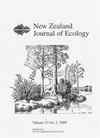步枪兵数量下降的情况下的招募、生存和繁殖成功
IF 1.4
3区 环境科学与生态学
Q3 ECOLOGY
引用次数: 0
摘要
我们使用了在Kaikōura附近的Kowhai Bush的一个彩色带状步枪(Acanthisitta chloris)种群中收集的详细生活史数据,以估计种群的生命率,并评估它们对同期种群下降的可能贡献。与其他种群的报告相比,平均少年存活率(18%)和平均成年存活率(49%)都较低。相比之下,繁殖成功率很高,一对平均每季度产3只雏鸟。高繁殖成功率可能与巢箱的使用有关。然后,我们使用生存和繁殖成功估计来参数化种群矩阵模型,该模型的扰动分析证实了预测的负趋势,即招募减少对种群下降的绝对贡献最大。我们讨论了观察到的相对较低的招募率和存活率的可能解释。来自经历稳定或正人口轨迹的其他步枪兵人口的数据对于更好地了解影响生命率的因素以及确定步枪兵人口面临下降风险的阈值特别有用本文章由计算机程序翻译,如有差异,请以英文原文为准。
Recruitment, survival and breeding success in a declining rifleman population
: We used detailed life-history data collected over a six-year period from a colour-banded population of riflemen ( Acanthisitta chloris ) at Kowhai Bush, near Kaikōura, to estimate population vital rates and assess their likely contribution to a concurrent population decline. Both mean juvenile survival (18%) and mean adult survival (49%) were low in comparison with reports from other populations. In contrast, breeding success was high, with pairs producing c. 3 fledglings per season on average. High breeding success was likely associated with nestbox use. We then used survival and breeding success estimates to parameterise a population matrix model, and perturbation analysis of this model confirmed a projected negative trend, with reduced recruitment having the greatest absolute contribution to population decline. We discuss possible explanations for the comparatively low rates of recruitment and survival observed. Data from other populations of riflemen experiencing stable or positive population trajectories would be especially useful to better understand factors affecting vital rates, and to identify the thresholds that signal a rifleman population at risk of decline
求助全文
通过发布文献求助,成功后即可免费获取论文全文。
去求助
来源期刊

New Zealand Journal of Ecology
环境科学-生态学
CiteScore
3.00
自引率
12.50%
发文量
35
审稿时长
>36 weeks
期刊介绍:
The New Zealand Journal of Ecology is a biannual peer-reviewed journal publishing ecological research relevant to New Zealand/Aotearoa and the South Pacific. It has been published since 1952 (as a 1952 issue of New Zealand Science Review and as the Proceedings of the New Zealand Ecological Society until 1977). The Journal is published by the New Zealand Ecological Society (Inc.), and is covered by Current Contents/Agriculture, Biology and Environmental Science, GEOBASE, and Geo Abstracts.
 求助内容:
求助内容: 应助结果提醒方式:
应助结果提醒方式:


